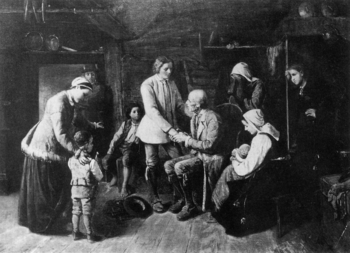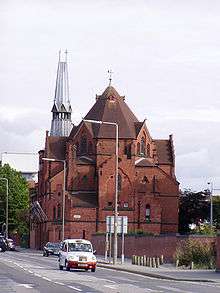Swedish diaspora



The Swedish diaspora consists of emigrants and their descendants, especially those that maintain some of the customs of their Swedish culture.[1] Notable Swedish communities exist in the United States, Argentina[2], Australia, Canada, Brazil, New Zealand, and the United Kingdom as well as others.
History
The New Sweden Company established a colony on the Delaware River in 1638, naming it New Sweden. The colony was lost to the Dutch in 1655.[3]
Between 1846 and 1930, roughly 1.3 million people, about 20% of the Swedish population, left the country.[4][5]
In the United States members of the diaspora had access to Swedish films starting in 1922 with The Treasure of Arne which was shown in Minneapolis, Minnesota. Some films were made just for the Swedish American diaspora community such as The Film About Sweden and The Old Land of Dreams.[6]
The first recognition by Sweden of the 19th century emigration to the United States occurred in 1923 with a visit by Nathan Söderblom and the 1926 visit by the crown prince, who would later rule as Gustaf VI Adolf of Sweden.[7][8] He would visit again in 1938.[9]
Swedish expatriates in Manhattan celebrate Midsummer as "a particularly grand example of the Swedish diaspora's ability to hold on to its culture while fully integrating on a global scale."[10]
Distribution
Finland
The Swedish-speaking Finns or Finland-Swedes form a minority group in Finland. The characteristic of this minority is debated: while some see it as an ethnic group of its own [11] some view it purely as a linguistic minority.[12] The group includes about 265,000 people, comprising 5.10% of the population of mainland Finland, or 5.50 %[13] if the 26,000 inhabitants of Åland are included (there are also about 60,000 Swedish-speaking Finns currently resident in Sweden). It has been presented that the ethnic group can also perceived as distinct Swedish-speaking nationality in Finland.[14] There are also 9,000 Swedish citizens living in Finland.[15]
Estonia
The presence of Swedish-speaking permanent residents in what is now Estonia (Estonian Swedes) was first documented in the 14th century, and possibly dates back to the Viking Age. There were an estimated 12,000 Swedes resident in Estonia in 1563, mainly distributed along the coastal regions and islands. Estonia was under Swedish rule 1558–1710, after which the territory was ceded to Russia in the 1721 Treaty of Nystad. In 1781, 1,300 Estonian Swedes of the island of Hiiumaa (Dagö) were forced to move to New Russia (today Ukraine) by Catherine II of Russia, where they formed Gammalsvenskby (Old Swedish Village). According to the 1934 census, there were 7,641 Estonian Swedes (Swedish speaking, 0.7% of the population in Estonia), making Swedes the third largest national minority in Estonia, after Russians and Germans. During World War II, almost the entire community of Estonian Swedes fled to Sweden. Today there are, at most, a few hundred Estonian Swedes living in Estonia and a few hundred in Russia and Ukraine, with the estimates varying widely depending on who identifies, or can be identified, as a Swede. Many of them are living in northwestern mainland Estonia and on adjacent islands and on the island of Ruhnu (Runö) in the Gulf of Riga.
In a nationalist context, the ethnic Swedes living outside Sweden are sometimes called 'East-Swedes' (in Swedish: östsvenskar), to distinguish them from the ethnic Swedes living in Sweden proper, called rikssvenskar.
France
Many Swedes spend their holidays in France especially in the South of France, small towns and villages. altogether totaling 20,000[16] to 25,000[16] Swedes in the Gallic country.[16]
North America
There are numerous Swedish descendants in places like the United States and Canada (i.e. Swedish Americans and Swedish Canadians), including some who still speak Swedish.
The majority of the early Swedish immigrants to Canada came via the United States. It wasn't until after 1880 that significant numbers of Swedes immigrated to Canada. From WWI onwards, almost all of the Swedish immigrants entered Canada coming directly from Sweden. In addition to Swedish immigrants from south-central part of Sweden, a relatively large number of Swedish immigrants came from Stockholm and northern Sweden. The newcomers played an important role in the development of the Canadian prairies.
Swedish Canadians can be found in all parts of the country. Many Swedish social, cultural, political, business and welfare organizations, both religious and secular, can be found in all major Canadian cities and some of the smaller towns and rural communities. Some of the Swedish traditions, such as Midsummer, Walpurgis, and St Lucia are still celebrated by the community today.[17]
Latin America
Swedes settled mainly in Argentina,[18] Brazil, Costa Rica and Chile. Numerous communities can be found in these countries, especially in Misiones Province and Buenos Aires, in Argentina, in the South and Southeast of Brazil, and there are some Swedish communities in southern Chile.
Oceania
Many Swedes settled in Australia and New Zealand. Organized immigration from Sweden occurred during the 19th century when Queensland and Tasmania invited immigrants to take up farming leases. Many people of Swedish descent can be found in these countries.
Russia
Swedish soldiers taken prisoner during the Great Northern War were sent in considerable numbers to Siberia. They numbered perhaps 25% of the population of Tobolsk, the capital of Siberia, and some settled permanently. There are also Swedes located in St Petersburg, in Ural and in Siberia.
United Kingdom
See also
References
- ↑ "Diaspora". Merriam Webster. Retrieved 2011-02-22.
the movement, migration, or scattering of a people away from an established or ancestral homeland ... people settled far from their ancestral homelands.
- ↑ "Suecia en Argentina". Web.archive.org. 12 June 2011. Archived from the original on 12 June 2011. Retrieved 20 August 2017.
- ↑ "A Brief History of New Sweden in America". Swedish Colonial Society. Retrieved 2011-02-22.
- ↑ "Swedish Emigrant Institute". Swedish Emigrant Institute. Archived from the original on 6 October 2013. Retrieved 22 February 2011.
Its original purpose was to preserve records, interviews, and memorabilia relating to the period of major Swedish emigration between 1846 and 1930 when 1.3 million (about 20%) of the Swedish population left the country.
- ↑ "Viveca". Palm Beach Daily News. 11 January 1983. Retrieved 2011-02-25.
... part of the 19th century Swedish diaspora from 1840 to 1910, 33 percent of Sweden's population left for Minnesota ...
- ↑ Mariah Larsson (2010). Swedish Film: An Introduction and a Reader. Nordic Academic Press. ISBN 91-85509-36-1.
As a comparison to these issues, and in order to see what happened to Swedishness in the diaspora, I am going to explore how the Swedish-Americans in special exhibitions used Swedish film to remember their home country and to construct their cultural identity as Swedish ...
- ↑ Orm Øverland (2000). Immigrant minds, American identities: making the United States home, 1870-1930.
These trips inaugurated an official recognition of what, from a Swedish point of view, now was a Swedish diaspora. ...
- ↑ "Prince Has Busy Day Seeing Washington. Dined By Coolidges. Gustavus Adolphus Visits House and Senate and Museum of the Capitol. He Is Thrilled By Fossils. Becomes So Absorbed in the Biological Specimens That He Almost Forgets Other Affairs. Banquet At White House. Royal Couple Attend Luncheon at the British Embassy and Reception at Home of John Hays Hammond". New York Times. 29 May 1926. Retrieved 2011-02-26.
A brilliant dinner by President and Mrs. Coolidge at the White House tonight, attended by every member of the Cabinet in Washington and other distinguished guests, topped off a lively day for Crown Prince Gustavus Adolphus and Crown Princess Louise of Sweden, which was divided between sight, seeing and a round of social functions.
- ↑ "Gustaf Adolf Returns to America For Delaware's Colonial Celebration. Many Official Duties. A Student in Norway. Athlete and Sportsman. A Man Who Enjoys Life". New York Times. 26 June 1938. Retrieved 2011-02-26.
For the first time since 1926, Crown Prince Gustaf Adolf of Sweden will arrive in the United States tomorrow. Accompanied by his wife and his third son, Prince Bertil, he will take part in the celebration marking ...
- ↑ "Expat Swedes gather for Manhattan Midsummer". The Local. 28 June 2010. Retrieved 2011-02-25.
The New York City Midsummer celebration is a particularly grand example of the Swedish diaspora's ability to hold on to its culture while fully integrating on a global scale.
- ↑ "...Finland has a Swedish-speaking minority that meets the four major criteria of ethnicity, i.e. self-identification of ethnicity, language, social structure and ancestry (Allardt and Starck, 1981; Bhopal, 1997).
- ↑ ...As language is actually the basic or even the only criterion that distinguishes these two groups from each other, it is more correct to speak of Finnish-speakers and Swedish-speakers in Finland instead of Finns and Finland Swedes. Nowadays the most common English term denoting the latter group is ‘the Swedish-speaking Finns’.
- ↑ Archived 11 October 2004 at the Wayback Machine.
- ↑ The identity of the Swedish[-speaking] minority [in Finland] is however clearly Finnish (Allardt 1997:110). But their identity is twofold: They are both Finland Swedes and Finns (Ivars 1987)." (Die Identität der schwedischen Minderheit ist jedoch eindeutig finnisch (Allardt 1997:110). Ihre Identität ist aber doppelt: sie sind sowohl Finnlandschweden als auch Finnen (Ivars 1987).) Saari, Mirja: Schwedisch als die zweite Nationalsprache Finnlands . Retrieved 10 December 2006.
- ↑ "It is not correct to call a nationality a linguistic group or minority, if it has developed culture of its own. If there is not only a community of language, but also of other characteristics such as folklore, poetry and literature, folk music, theater, behavior.etc". "The concept of nation has a different significance as meaning of a population group or an ethnic community, irrespectively of its organization. For instance, the Swedes of Finland, with their distinctive language and culture form a nationality which under the Finnish constitution shall enjoy equal rights with the Finnish nationality"."In Finland this question (Swedish nationality) has been subjected to much discussion.The Finnish majority tries to deny the existence of a Swedish nationality. An example of this is the fact that the statutes always use the concept "Swedish-speaking" instead of Swedish". Tore Modeen, The cultural rights of the Swedish ethnic group in Finland (Europa Ethnica, 3-4 1999,jg.56)
- 1 2 3 "Présentation de la Suède". France Diplomatie : : Ministère de l'Europe et des Affaires étrangères.
- ↑ "Community Life | Multicultural Canada". Multiculturalcanada.ca. Retrieved 2010-07-08.
- ↑ http://www.nordicway.com/argentina.htm
